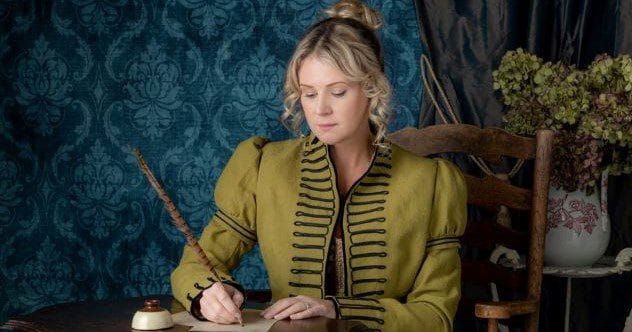Step back in time to the Victorian Age, a period of exciting inventions but also surprising dangers. While people marveled at new technologies, their homes often hid everyday items that could be deadly. Forget spooky ghosts; the real threats in Victorian houses were things people used every day. Let’s uncover 10 shocking items in a Victorian home that could actually turn fatal.
10 Pretty Poison: The Deadly Allure of Green Wallpaper
In Victorian times, a vibrant green color was all the rage. It appeared in beautiful dresses, carpets, and, most dangerously, wallpaper. This popular shade, known as Scheele’s Green, was made with arsenic, a potent poison. Even Queen Victoria used it in Buckingham Palace, making it trendy.
The problem was that this arsenic-laced wallpaper was incredibly dangerous. As it aged, it would release arsenic dust into the air. Simply breathing in a room with this wallpaper could lead to arsenic poisoning. Little children were especially at risk, as they might pick off and eat flakes of the sweet-tasting wallpaper. It’s estimated there were millions of square miles of this deadly wallpaper in British homes before it was finally banned.
9 The Bathroom: A Steamy, Explosive Chamber
Victorians prized cleanliness and were excited about the idea of a dedicated bathroom. However, these new bathrooms came with their own set of dangers. Gas-powered water heaters for bathtubs were a marvelous invention, but they lacked thermostats. This meant there was no way to control the water temperature accurately.
People could, and sometimes did, accidentally boil themselves alive. Newspapers of the era reported on such horrifying incidents. But the bathtub wasn’t the only hazard. Early plumbing systems weren’t very efficient. They often failed to remove waste properly, leading to a buildup of methane gas from decomposing sewage. Methane is highly flammable, and if it mixed with air in the right proportions, a single spark could cause a devastating explosion.
8 Gas Lighting: Illuminating Homes with Danger
Gas lighting was a major step forward, allowing businesses to stay open longer and homes to be brightly lit after dark. However, this innovation was fraught with peril. The gas used, especially coal gas, was a dangerous cocktail. It contained flammable methane and hydrogen, but also toxic sulfur and deadly carbon monoxide.
Worse still, they hadn’t yet thought to add a smelly substance (like mercaptan, which we use today) to detect gas leaks. So, a leak could go unnoticed, filling a home with explosive or poisonous gas. This led to countless house fires, explosions, and deaths from carbon monoxide poisoning or suffocation. Victorian news reporters frequently covered these tragic events.
7 Painted Peril: Lead’s Lethal Touch
Lead was once seen as a miracle additive for paint, especially for protecting outdoor metal structures from rust. Unfortunately, its use extended to interior paints for homes, long before people understood how toxic lead truly is. Lead found its way into many household items, including wallpaper and, tragically, children’s toys.
The bright, appealing colors of these toys often came from lead-based paint. This was a deadly combination because lead has a slightly sweet taste. This encouraged young children, who naturally explore the world by putting things in their mouths, to suck or chew on these toys. This exposed them to lead poisoning, leading to severe health problems and even death. It took many such tragedies before the dangers were recognized and lead paint was banned for such uses.
6 Treacherous Treads: The Perilous Staircases
As cities grew rapidly during the Victorian era, housing became a major issue. To accommodate more people, apartment buildings were built taller, narrower, and closer together. This design often resulted in staircases that were dangerously steep and constructed quickly and cheaply, using inferior wood.
Many of these staircases lacked proper handrails, making them even more hazardous. A simple misstep could lead to a fatal tumble. Broken necks were a common and tragic outcome. Thousands of Victorians lost their lives falling down these poorly designed stairs. Shockingly, many of these old, perilous staircases still exist in buildings today, continuing to pose a risk.
5 Vanity’s Flame: Explosive Beauty Accessories
In the pursuit of affordable alternatives to expensive materials like ivory or tortoise shell, an inventor named Alexander Parkes created Parkesine in 1862. This early form of plastic, later known as celluloid, could be molded into various shapes and was used for items like combs and decorative vanity pieces.
While it seemed like a clever innovation, Parkesine had a terrifying secret: it was highly volatile. It could spontaneously burst into flames without warning, or explode if it came too close to an open flame, like a candle or gas lamp. A woman trying to save money on beauty accessories could unknowingly bring a highly combustible material into her home, risking a devastating fire and endangering her entire family.
4 Beauty’s Dark Side: Killer Cosmetics
Victorian women had access to a growing array of beauty products, but many of them contained dangerous ingredients. Toothpaste might contain camphor, which could be deadly if swallowed. Eye makeup, or “eye powder,” could be made with harmful substances like mercury or lead.
To achieve the fashionable look of dilated pupils, women used eye drops containing belladonna, derived from the deadly nightshade plant. For weight loss, some resorted to swallowing tapeworm larvae, hoping the parasites would consume their calories. This, of course, led to severe malnutrition and illness. Using these beauty aids was a gamble with health, and sometimes life itself.
3 Laudanum: The Cure-All That Addicted a Nation
Laudanum was the Victorian era’s go-to remedy for almost any ailment. It was a potent mixture, typically containing 10% opium (which includes morphine and codeine) and a high percentage of alcohol, sometimes as much as 50%. To mask its bitter taste, it was often flavored with everything from honey and spices to chloroform and even mercury.
Marketed heavily towards women for issues like headaches, menstrual pain, and “hysteria,” laudanum was frightfully addictive. People used it for aches and pains, many of which might have been caused by other household dangers like arsenic wallpaper. Because it was easily available and seemed to work, dependency was common, leading to severe withdrawal symptoms and frequent, often fatal, overdoses.
2 A Shopping Trip’s Lethal Souvenirs
Everyday items brought home from a shopping trip could introduce new dangers into the Victorian household. Candies might be made with potassium chlorate, a substance that could be harmful. Powdered lemonade sold in metal cans could become toxic if the acidic powder reacted with the can, leaching antimony, which harms the stomach, lungs, and heart.
For babies, a mother might buy “Mrs. Wilmslow’s Soothing Syrup.” This syrup effectively quieted a crying baby because it contained morphine, a powerful opiate. Cleaning products, too, posed a threat. Some household cleaning powders contained carbolic acid, which is fatal if ingested. Alarmingly, these dangerous powders were often packaged in containers that looked very similar to food items, leading to tragic accidental poisonings.
1 Murder Bottles: Babies’ Deadly Drink
During the Victorian era, societal pressure and popular household guides sometimes discouraged breastfeeding. This led to the widespread use of baby-feeding bottles. Unfortunately, many of these bottles had design flaws that made them incredibly dangerous, earning them the grim nickname “murder bottles.”
The bottles often had a slanted shape that was difficult to clean thoroughly, allowing old milk to curdle and harbor bacteria. Worse, the nipple rings were sometimes made from porous materials that acted like sponges, soaking up bacteria and promoting their growth. It was almost impossible to sterilize these parts effectively. Babies drinking from these contaminated bottles were at high risk of contracting fatal diseases like typhoid, dysentery, and severe intestinal infections. Thousands of infants tragically died, with no one fully understanding the silent killer in their feeding bottle.
The Victorian home, with all its period charm, was also a landscape of unseen perils. From the walls to the medicine cabinet, dangers lurked where families least expected them. It’s a stark reminder of how much we’ve learned about safety and science, making our modern homes far healthier places to live.
What Victorian household danger do you find the most shocking? Share your thoughts in the comments below!










